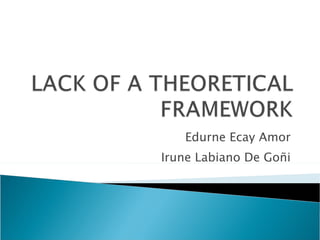4. Edurne Ecay and Irune Labiano - Lack of a theoretical framework
- 1. Edurne Ecay Amor Irune Labiano De Goñi
- 2. A lack of CALL guidelines has meant that CALL authors have no reliable conceptual framework. But It is necessary a generally accepted theoretical framework that authors can use to guide their work.
- 3. A general theoretical framework has not emerged for a number of reasons. Materials developers fall into two broad bands in their approach to their work: On the one side, many developers rely on their intuition as teachers rather than on learning research (practitioner not researcher) On the other side, there are many developers who are primarily interested in solving problems by formulating theory (formalists), and many other who prefer to solve problems by writing programs (proceduralists)
- 4. A perception of this division was reiterated at two CALL Conferences: The EURO CALL Conference in Valencia The CALL Conference in Exeter, Sussex
- 5. Where theory has been used as a point of departure, the theoretical sources that have been proposed and used have been diverse. For example: Theories emanating from psychology (cognitive psychology and Second Language Acquisition) are usually drawn from a restricted context to the CALL context in general.
- 6. Integrated frameworks have been proposed, such as Hubbard or Mitterer et al. who suggest an integrated framework using theories from instructional design, language teaching, language learning, and knowledge of the applicability of the technology. Integrated frameworks recognize the multifaceted nature of CALL materials development A number of CALL projects have not been driven directly by theory as such. This CALL projects include vocational language programs which begin with addressing student needs: KanjiCard which uses a specific language problem as a point of departure CLEF where developing grammar skills is the goal
- 7. It also seems apparent that some CALL projects do not begin with a theory at all Sussex stresses the importance of investigating the processes of CALL materials production At the present time rather little work has been done on the question of How teachers become CALL authors: how they objectify their knowledge domains learning, and teaching how they conceptualize learning materials and learning modes for transfer to the CALL medium how they achieve this transfer how the existence and use of CAL media influence theories of CALL, and vice versa.
- 8. Reviewing what has already been done, and by exploring the ways in which CALL is conceptualized, a clearer understanding of theory and practice will emerge. This book attempts to address these areas of concern by shedding light on the nature of the problems. Such a description has the potential to improve our understanding of: the scope of CALL and prominent areas of focus within it the theoretical sources and conceptual frameworks of CALL authors the possible weaknesses or gaps between theory and practice.







